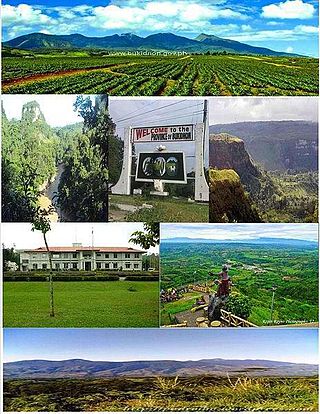
Bukidnon, officially the Province of Bukidnon, is a landlocked province in the Philippines located in the Northern Mindanao region. Its capital is the city of Malaybalay while Valencia is the largest city. The province borders, clockwise from the north, Misamis Oriental, Agusan del Sur, Davao del Norte, Cotabato, Lanao del Sur, and Lanao del Norte. According to the 2020 census, the province is inhabited by 1,541,308 residents. The province is composed of 2 component cities and 20 municipalities. It is the third largest province in the country in terms of total area of jurisdiction behind Palawan and Isabela respectively.
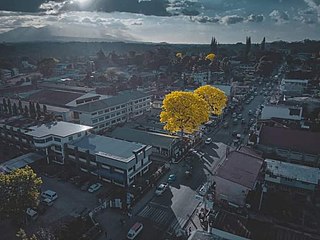
Malaybalay, officially the City of Malaybalay, is a 1st class component city and capital of the province of Bukidnon, Philippines. According to the 2020 census, it has a population of 190,712 people.

Lantapan, officially the Municipality of Lantapan, is a 1st class municipality in the province of Bukidnon, Philippines. According to the 2020 census, it has a population of 65,974 people.

Cabanglasan, officially the Municipality of Cabanglasan, is a 3rd class municipality in the province of Bukidnon, Philippines. According to the 2020 census, it has a population of 36,286 people.

Dangcagan, officially the Municipality of Dangcagan, is a 3rd class municipality in the province of Bukidnon, Philippines. According to the 2020 census, it has a population of 26,076 people, making it the least populated municipality in the province.

Impasugong, officially the Municipality of Impasugong, is a 1st class municipality in the province of Bukidnon, Philippines. According to the 2020 census, it has a population of 53,863 people.
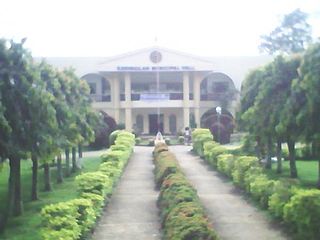
Kadingilan, officially the Municipality of Kadingilan, is a 3rd class municipality in the province of Bukidnon, Philippines. According to the 2020 census, it has a population of 33,735 people.
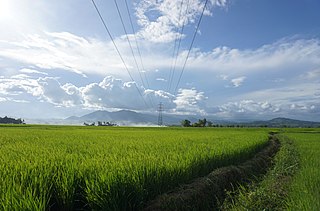
Maramag, officially the Municipality of Maramag, is a 1st class municipality in the province of Bukidnon, Philippines. According to the 2020 census, it has a population of 108,293 people.

Pangantucan, officially the Municipality of Pangantucan, is a 1st class municipality in the province of Bukidnon, Philippines. According to the 2020 census, it has a population of 56,580 people.

San Fernando, officially the Municipality of San Fernando, is a 1st class municipality in the province of Bukidnon, Philippines. According to the 2020 census, it has a population of 63,045 people.

Sumilao, officially the Municipality of Sumilao, is a 4th class municipality in the province of Bukidnon, Philippines. According to the 2020 census, it has a population of 29,531 people.

The Pulangi River ;, also spelled Pulangui, is one of the major tributaries of the Rio Grande de Mindanao, an extensive river system in Mindanao, Philippines. With a length of 320 kilometres (199 mi), it is the longest river in Bukidnon and the 5th longest river in the Philippines. It traverses through majority of the cities and municipalities of Bukidnon from its source in Barangay Kalabugao, Impasugong, Bukidnon.
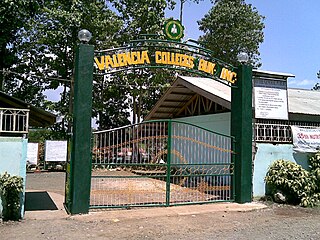
Valencia Colleges (Bukidnon), Incorporated (VCI), is a private non-sectarian institution of higher learning located at Hagkol, Valencia City, Bukidnon, Philippines. Established in 1989, it is a non-stock corporation. It offers preschool, grade school, junior high school, senior high school, college, and graduate school.
The Sawaga River is a river in Central Bukidnon, Philippines on the island of Mindanao. A majority of its catchment area is located in Malaybalay City. Its source is from a watershed west of Mt. Tuminungan in Barangay Dalwangan. It flows shortly northward and then eastward into Patpat and Kalasungay, the river then flows southward into the Poblacion District, past Casisang, San Jose, and Laguitas. The Lower Sawaga Valley is located in its lower course from Barangay Linabo through Bangcud until it meets with the Manupali River and ends at Pulangi River in Kahaponan, Valencia City. The Sawaga River has a total length of about 64.5 km and the basin has a total of 42,692 hectares.
Bangcud is an urban barangay in the South Highway District of Malaybalay City, Bukidnon, in the Philippines.

Can-ayan is a rural barangay in the North Highway District of Malaybalay City, Bukidnon, Philippines. According to the 2015 census, Can-ayan has a population of 5,870 people.
Busdi is a rural barangay of the Upper Pulangi District of Malaybalay, Bukidnon, Philippines. According to the 2015 census, it has a population of 2,377 people. It is bounded to the north by Barangay Bulonay of Impasug-ong, to the east by the Municipality of La Paz, Agusan del Sur, to the south by Saint Peter and Kulaman, and to the west by Kibalabag and Manalog.
Mailag is an urban barangay in Valencia, Bukidnon, Philippines. According to the 2015 census, it has a population of 6,805 people.
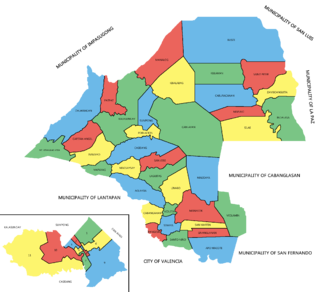
Malaybalay, the capital of Bukidnon, is subdivided into 46 barangays. The Philippine Standard Geographic Code classifies 15 barangays as urban and 31 rural; however, the City of Malaybalay classifies 18 barangays as urban and 28 rural. These barangays are grouped into five administrative districts, namely Basakan, North Highway, Poblacion, South Highway, and Upper Pulangi.
Santo Niño is a rural barangay in the Basakan District of Malaybalay, Bukidnon, Philippines. According to the 2015 census, it has a population of 1,675 people. It is bordered to the north by Simaya and San Martin, to the east by Sinanglanan and Apo Macote, to the south by Nabag-o of the City of Valencia, and to the west by Bangcud and Mailag.




































